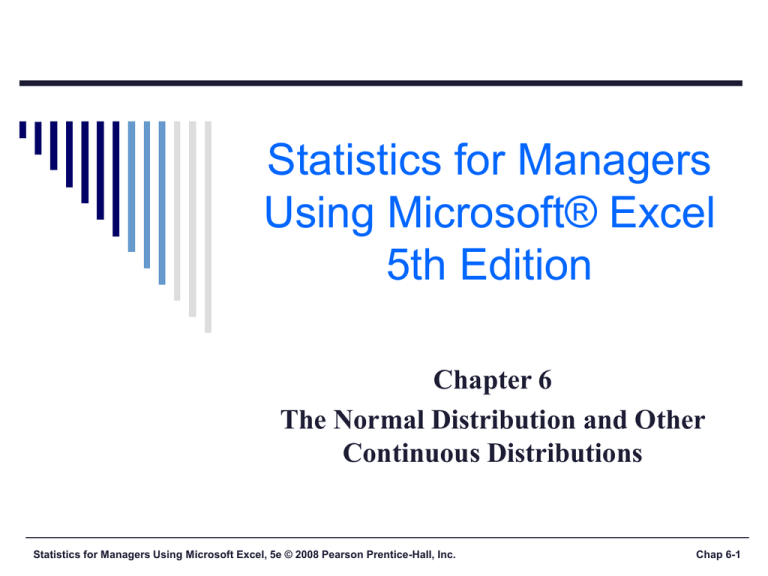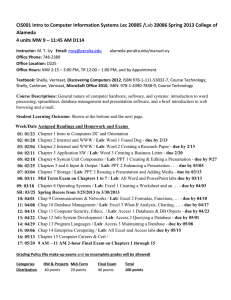
Statistics for Managers
Using Microsoft® Excel
5th Edition
Chapter 6
The Normal Distribution and Other
Continuous Distributions
Statistics for Managers Using Microsoft Excel, 5e © 2008 Pearson Prentice-Hall, Inc.
Chap 6-1
Learning Objectives
In this chapter, you will learn:
To compute probabilities from the normal
distribution.
To use the normal probability plot to determine
whether a set of data is approximately normally
distributed.
To compute probabilities from the uniform
distribution.
To compute probabilities from the exponential
distribution
Statistics for Managers Using Microsoft Excel, 5e © 2008 Pearson Prentice-Hall, Inc.
Chap 6-2
Continuous Probability
Distributions
A continuous random variable is a variable that can
assume any value on a continuum (can assume an
uncountable number of values)
thickness of an item
time required to complete a task
temperature of a solution
height
These can potentially take on any value, depending only
on the ability to measure precisely and accurately.
Statistics for Managers Using Microsoft Excel, 5e © 2008 Pearson Prentice-Hall, Inc.
Chap 6-3
Probability Distribution
Overview
Probability
Distributions
Ch. 5
Discrete
Probability
Distributions
Continuous
Probability
Distributions
Binomial
Normal
Poisson
Uniform
Hypergeometric
Exponential
Statistics for Managers Using Microsoft Excel, 5e © 2008 Pearson Prentice-Hall, Inc.
Ch. 6
Chap 6-4
The Normal Distribution
Properties
‘Bell Shaped’
f(X)
Symmetrical
Mean, Median and Mode are equal
σ
Location is characterized by the mean, μ
Spread is characterized by the standard
deviation, σ
The random variable has an infinite
theoretical range: - to +
Statistics for Managers Using Microsoft Excel, 5e © 2008 Pearson Prentice-Hall, Inc.
μ
Mean
= Median
= Mode
Chap 6-5
The Normal Distribution
Density Function
The formula for the normal probability density function is
1
f(X)
e
2π
1 (X μ)
2
2
Where e = the mathematical constant approximated by 2.71828
π = the mathematical constant approximated by 3.14159
μ = the population mean
σ = the population standard deviation
X = any value of the continuous variable
Statistics for Managers Using Microsoft Excel, 5e © 2008 Pearson Prentice-Hall, Inc.
Chap 6-6
Normal Probabilities
Probability is measured by the area under the curve
f(X)
P(a ≤ X ≤ b)
(Note that the probability
of any individual value is
zero)
a
b
Statistics for Managers Using Microsoft Excel, 5e © 2008 Pearson Prentice-Hall, Inc.
Chap 6-7
Normal Probability Tables
The column gives the value of Z
to the second decimal point
Z
The row shows
the value of Z to
the first decimal
point
0.00
0.01
0.02 …
0.0
0.1
.
.
.
2.0
.9772
The value within the table
gives the probability from
Z = up to the desired
Z value.
2.0
P(Z < 2.00) = .9772
Statistics for Managers Using Microsoft Excel, 5e © 2008 Pearson Prentice-Hall, Inc.
Chap 6-8
Finding Normal Probability
Example
Let X represent the time it takes (in seconds) to
download an image file from the internet.
Suppose X is normal with mean 8.0 and
standard deviation 5.0
Find P(X < 8.6)
X
8.0
8.6
Statistics for Managers Using Microsoft Excel, 5e © 2008 Pearson Prentice-Hall, Inc.
Chap 6-9
Finding Normal Probability
Example
Let X represent the time it takes (in seconds) to
download an image file from the internet.
Suppose X is normal with mean 8.0 and
standard deviation 5.0
Find P(X > 8.6)
=1-P(X < 8.6)
X
8.0
8.6
Statistics for Managers Using Microsoft Excel, 5e © 2008 Pearson Prentice-Hall, Inc.
Chap 6-10
PhStat – Normal Probabilities
PhStat | Probabilities &Prob. Distributions |
Normal
Statistics for Managers Using Microsoft Excel, 5e © 2008 Pearson Prentice-Hall, Inc.
Chap 6-12
Assessing Normality
It is important to evaluate how well the data set
is approximated by a normal distribution.
Normally distributed data should approximate
the theoretical normal distribution:
Statistics for Managers Using Microsoft Excel, 5e © 2008 Pearson Prentice-Hall, Inc.
Chap 6-13
Assessing Normality
Construct charts or graphs
For small- or moderate-sized data sets, do the
stem-and-leaf display and box-and-whisker plot look
symmetric?
For large data sets, does the histogram or polygon
appear bell-shaped?
Compute descriptive summary measures
Do the mean, median and mode have similar values?
Is the interquartile range approximately 1.33 σ?
Is the range approximately 6 σ?
Statistics for Managers Using Microsoft Excel, 5e © 2008 Pearson Prentice-Hall, Inc.
Chap 6-14
Assessing Normality
Observe the distribution of the data set
Do approximately 2/3 of the observations lie within
mean ± 1 standard deviation?
Do approximately 95% of the observations lie within
mean ± 2 standard deviations?
Evaluate normal probability plot
Is the normal probability plot approximately linear
with positive slope?
Statistics for Managers Using Microsoft Excel, 5e © 2008 Pearson Prentice-Hall, Inc.
Chap 6-15
The Normal Probability Plot
A normal probability plot for data from a normal
distribution will be approximately linear:
X
90
60
30
-2
-1
0
1
Statistics for Managers Using Microsoft Excel, 5e © 2008 Pearson Prentice-Hall, Inc.
2
Z
Chap 6-16
The Normal Probability Plot
Left-Skewed
Right-Skewed
X 90
X 90
60
60
30
30
-2 -1 0
1
2 Z
-2 -1 0
1
2 Z
Rectangular
X 90
Nonlinear plots indicate a
deviation from normality
60
30
-2 -1 0
1
2 Z
Statistics for Managers Using Microsoft Excel, 5e © 2008 Pearson Prentice-Hall, Inc.
Chap 6-17
PhStat – Normal Probability Plot
PhStat | Probabilities &Prob. Distributions |
Normal Probability Plot…
Need actual data
Statistics for Managers Using Microsoft Excel, 5e © 2008 Pearson Prentice-Hall, Inc.
Chap 6-18
The Uniform Distribution
Probability
Distributions
Continuous
Probability
Distributions
Normal
Uniform
Exponential
Statistics for Managers Using Microsoft Excel, 5e © 2008 Pearson Prentice-Hall, Inc.
Chap 6-19
The Uniform Distribution
The uniform distribution is a probability
distribution that has equal probabilities for all
possible outcomes of the random variable
Because of its shape it is also called a
rectangular distribution
Statistics for Managers Using Microsoft Excel, 5e © 2008 Pearson Prentice-Hall, Inc.
Chap 6-20
The Uniform Distribution
The Continuous Uniform Distribution:
1
ba
if a X b
0
otherwise
f(X) =
where
f(X) = value of the density function at any X value
a = minimum value of X
b = maximum value of X
Statistics for Managers Using Microsoft Excel, 5e © 2008 Pearson Prentice-Hall, Inc.
Chap 6-21
The Uniform Distribution
The mean of a uniform distribution is:
ab
μ
2
The standard deviation is:
σ
(b - a)2
12
Statistics for Managers Using Microsoft Excel, 5e © 2008 Pearson Prentice-Hall, Inc.
Chap 6-22
The Uniform Distribution
Example: Uniform probability distribution
over the range 2 ≤ X ≤ 6:
1
f(X) = 6 - 2 = .25 for 2 ≤ X ≤ 6
f(X)
μ
.25
2
6
X
σ
Statistics for Managers Using Microsoft Excel, 5e © 2008 Pearson Prentice-Hall, Inc.
ab 26
4
2
2
(b - a) 2
12
(6 - 2) 2
1.1547
12
Chap 6-23
Uniform Distribution Example
Uniform distribution: Probability Calculations
f(X)
No PhStat Calculator – manual calculation
c-a
P(X c) =
b-a
b-c
P(X c) = b - a
d-c
P(c X d) = b - a
a
c
d
b
X
Statistics for Managers Using Microsoft Excel, 5e © 2008 Pearson Prentice-Hall, Inc.
Chap 6-24
Uniform Distribution Example
Uniform distribution: Probability Calculations
f(X)
No PhStat Calculator – manual calculation
3-2
P(X 3) =
=.25
6-2
6-3
P(X 3) = 6 - 2 =.75
4-3
P(3 X 4) =
6 - 2=.25
2
3
4
X
6
Statistics for Managers Using Microsoft Excel, 5e © 2008 Pearson Prentice-Hall, Inc.
Chap 6-25
The Exponential Distribution
Probability
Distributions
Continuous
Probability
Distributions
Normal
Uniform
Exponential
Statistics for Managers Using Microsoft Excel, 5e © 2008 Pearson Prentice-Hall, Inc.
Chap 6-26
The Exponential Distribution
Used to model the length of time between two
occurrences of an event (the time between arrivals)
Examples:
Time between trucks arriving at an unloading
dock
Time between transactions at an ATM
Machine
Time between phone calls to the main
operator
Statistics for Managers Using Microsoft Excel, 5e © 2008 Pearson Prentice-Hall, Inc.
Chap 6-27
The Exponential Distribution
Defined by a single parameter, its mean λ (lambda)
The probability that an arrival time is less than some
specified time X is
P(arrival time X) 1 e λX
where
e = mathematical constant approximated by 2.71828
λ = the population mean number of arrivals per unit
X = any value of the continuous variable where 0 < X <
Statistics for Managers Using Microsoft Excel, 5e © 2008 Pearson Prentice-Hall, Inc.
Chap 6-28
The Exponential Distribution
Example: Customers arrive at the service counter at the rate
of 15 per hour. What is the probability that the arrival time
between consecutive customers is less than three minutes?
The mean number of arrivals per hour is 15, so λ = 15
Three minutes is .05 hours
P(arrival time < .05) = 1 – e-λX = 1 – e-(15)(.05) = .5276
So there is a 52.76% probability that the arrival time
between successive customers is less than three minutes
Statistics for Managers Using Microsoft Excel, 5e © 2008 Pearson Prentice-Hall, Inc.
Chap 6-29
Exponential Distributions
Describes time or distance between events
is the inverse of the Poisson distribution.
f(x)
Density function
f ( x)
Parameters
1
x
e
Statistics for Managers Using Microsoft Excel, 5e © 2008 Pearson Prentice-Hall, Inc.
X
Chap 6-30
PhStat – Exponential Distribution
PhStat | Probabilities &Prob. Distributions |
Exponential…
Statistics for Managers Using Microsoft Excel, 5e © 2008 Pearson Prentice-Hall, Inc.
Chap 6-31
Chapter Summary
In this chapter, we have
Presented key continuous distributions
normal, uniform, exponential
Found probabilities using formulas and tables
Recognized when to apply different distributions
Applied distributions to decision problems
Statistics for Managers Using Microsoft Excel, 5e © 2008 Pearson Prentice-Hall, Inc.
Chap 6-32



